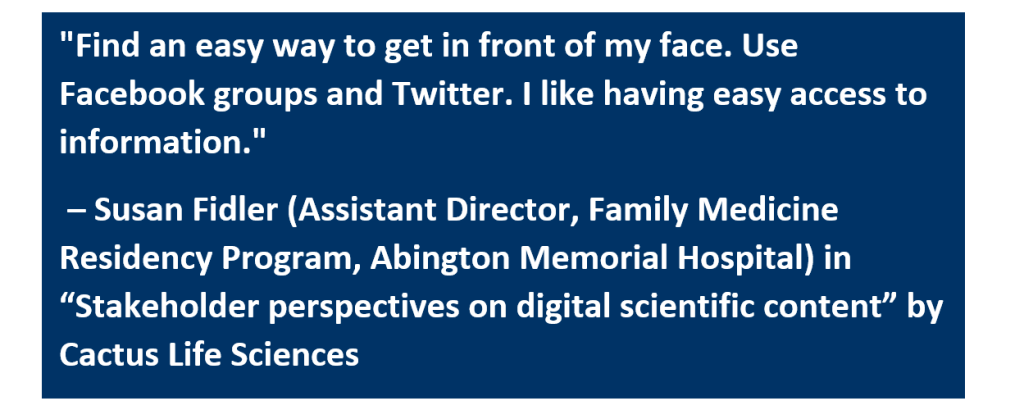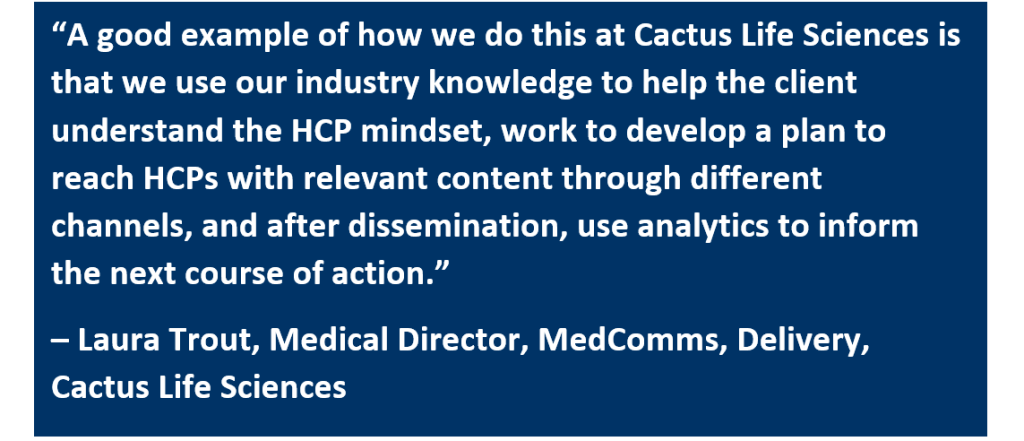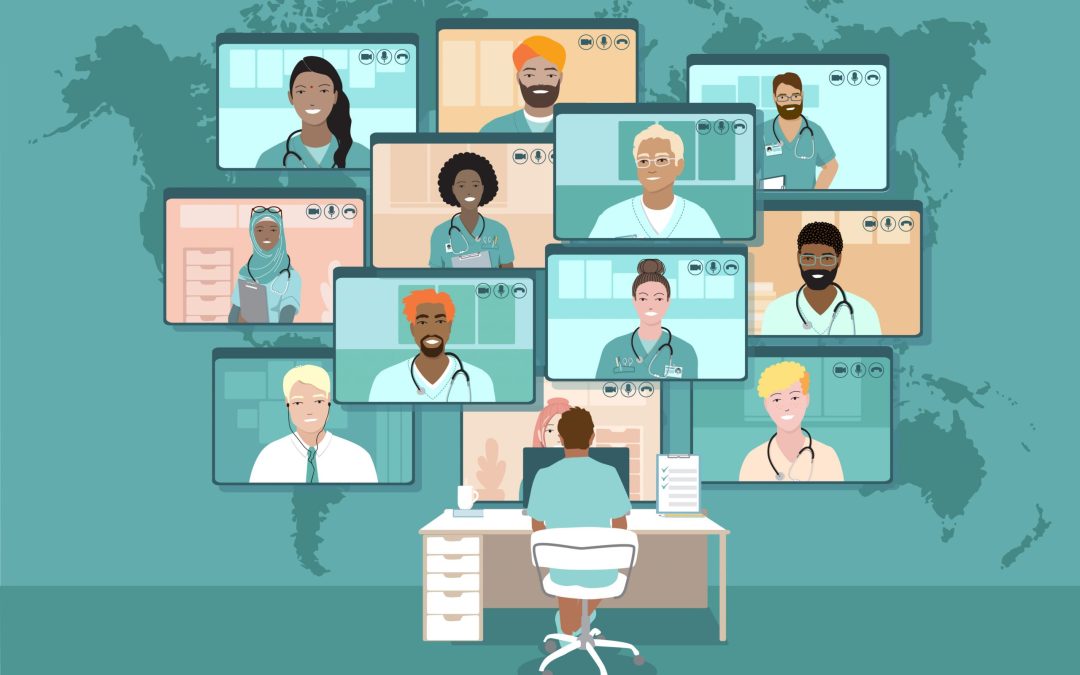More than 80% of physicians are working at full capacity or are overworked and 78% “sometimes, often, or always experience feelings of burnout.” This has had an impact on their interactions with pharma. As per a survey, the percentage of primary care physicians who report having no interactions with pharma reps increased from 21% in 2018 to 40% in 2019. Moreover, in-person contact between healthcare professionals (HCPs) and pharma reps has decreased even further after the pandemic hit, causing the HCPs, like their patients, to move online in search of information to help with healthcare decisions and to interact with peers. Consequently, pharma has followed them there but is struggling with effective HCP engagement.
So how can pharma engage HCPs better digitally?
A deluge of information hits HCPs when they search about recent advancements in the industry, the available drugs and treatment options, new drugs and treatments hitting the market, disease states, prescription protocols, drug side-effects, etc. Thus, they need concise, valuable, engaging, and easy-to-access information whenever, wherever, and however they want it. Below are 4 ways to achieve this.
1. Creating high-value HCP-centric content
Big Pharma spends more on consumer marketing than on R&D – an average of $3 billion is annually spent on D2C marketing, while a lion’s share i.e., approximately $24 million is spent on marketing to physicians and other HCPs. Yet, 23%–50% of physicians are not satisfied with pharma’s digital interactions. Thus, when communicating with HCPs, pharma needs to elevate its marketing strategy to put out succinct, high-value, and targeted content that is easy-to-understand at a glance. For example, if a graphic is too complex or confusing, the HCP will either ignore it or lose interest very quickly.
This can be challenging because marketing to HCPs is multifaceted. It is hence very important to listen to what HCPs are saying; identify their needs by practice area, geography, pain points/challenges, channel preferences, unique requirements, etc.; and tailor content solutions accordingly. This does not mean that pharma would have to create new content from scratch every single time – repurposing the existing content for a relevant platform and in a required format for the target audience would work just fine. The key is to avoid adding unnecessarily to the information avalanche and help HCPs manage and extract information by personalizing content.

The problems of HCPs become the problems of pharma marketers, and HCPs are crying for help from pharma to ease the burden of their daily practice and for assistance with the transition that the industry is undergoing. As per a survey by the Medical Affairs Professionals Society, in early 2021, 87% HCPs selected “updated scientific data” and 56% each selected “research information and education” and “therapeutic area discussion/treatment landscape and approach” as the preferred topics of discussion. Thus, addressing HCP needs on a piecemeal basis is no longer an option. What pharma needs is people-based marketing. One example of an HCP-centered approach would be to make it easier to find drug-related information and provide a 24×7 chatbot service on pharma websites.
2. Adopting an omnichannel approach
HCP needs are diverse. Therefore, pharma needs to let HCPs drive the marketing conversation. To do this, it is of utmost importance to consider all the different channels of communication that they use – emails, social media platforms, websites, online conferences and webinars, online forums and networks, etc. HCPs also have different preferences for content types and formats, depending on their schedules, clinical needs and setting, specialties, lifestyles, and professional expectations. Thus, thoughtful channel planning*—i.e., an omnichannel strategy that aligns various channels and puts across a consistent message—is necessary.
3. Choosing appropriate platforms and content types
Nowadays, more than 80% HCPs trust social media for exchange of scientific information, as a source of clinical information, and use* it widely in their medical practice. Twitter is considered the most popular platform within healthcare (one study showed that there was a 63% rise noticed in the page views for research articles that were tweeted about), and other platforms are catching up fast. HCP preferences for social media channels vary by region. For example, Twitter and LinkedIn are widely used in Europe, WeChat in China, and Instagram in Latin America. Other platforms gaining popularity among HCPs include Reddit, YouTube, and Clubhouse. With regard to the types of social media content that generates engagement and sparks interest, around 30%* of millennial HCPs describe posts shared by KOLs on social media channels as influential, and approximately 60%* of GenX HCPs prefer to regularly read what KOLs post. HCPs prefer diverse communication formats and more interactive content* such as videos, educational PDFs, infographics, articles, etc. To cut through the noise and provide optimal value, HCP-targeted content must be personalized, mobile-friendly, easily accessible, highly engaging, relevant, and delivered regularly.
4. Monitoring activity and collecting feedback
Measuring impact and engagement and monitoring audience activity helps pharma understand what works for HCPs and what doesn’t. It is crucial to be in constant touch with and listen to HCPs to continuously learn what they are asking for and deliver accordingly. It is quite possible that the channels or the formats of information they preferred in the past are no longer convenient for them. For example, Facebook use is declining in North America, and it may not be the preferred platform for some HCPs anymore. Similarly, information that worked for them a few years ago, may not be relevant now. Thus, pharma needs to collect, share, use, and incorporate customer insights proactively across all digital channels to keep HCPs engaged.
The medical communications and healthcare marketing landscapes are changing rapidly, and pharma cannot afford to be left behind. The end goal for pharma is to engage HCPs personally by allowing them to take the lead in the pharma marketing strategy, without overwhelming them.

At Cactus Life Sciences we use scientific acumen, cutting-edge creative and digital solutions, advanced technology, and transformational delivery models to redefine efficiency across the healthcare continuum by delivering personalized and impactful content that provides lasting quality and value. To know more, contact us today.
(*Certain sources that were cited here contain links that are now dead and have hence been removed from this article.)















